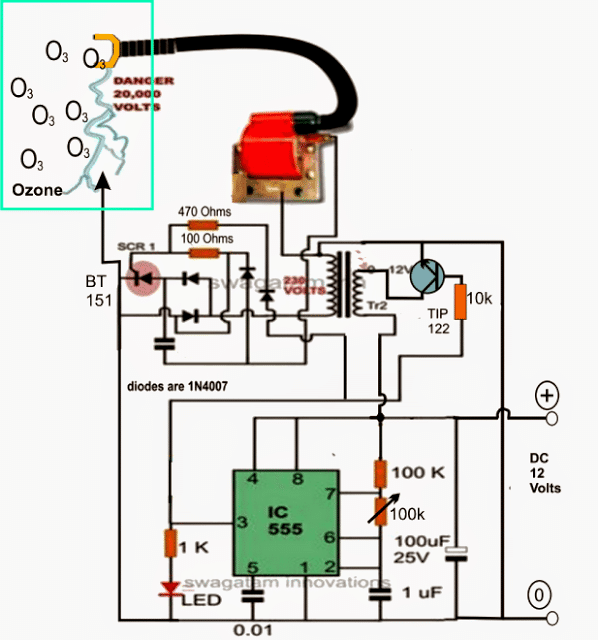We are all familiar with thundering and lightning during stormy weathers and know how the effect is responsible of producing a lot of ozone and negative ions in the atmosphere. The same concept has been employed in the proposed water and air sterilizer circuit.
Properties of Ozone
Ozone is a pale blue gas having a pungent order (akin to chlorine) with the chemical formula O3. In the atmosphere ozone may be produced due to the presence of strong UV rays or electrical discharges as during thunder lightnings.
The above mentioned phenomenon produce ozone basically by knocking down the dioxide oxygen molecules (O2) which are present plentifully in the atmosphere, resulting in O2 → 2O.
The resultant free radicals generated as 2O collide around the source forming O3 or Ozone. The process continues as long as the source (lightning arcs, UV rays) keep their presence.
By nature Ozone is a very strong oxidant even stronger than dioxide. This property of ozone is helpful in killing germs, parasites and other microorganisms which may be regarded as pests and hence is used as sterilizer for disinfecting water and air.
However, the strong oxidizing property of ozone could be also harmful for humans and animals and could cause respiratory issues if inhaled for longer periods of time inside a non-ventilated premise.
The above discussion shows that ozone can be actually produced very easily either through unsuppressed arcing or through UV rays and used for sterilizing water or air appropriately.
Implementing Unsuppressed Spark Arcing
In the proposed design we incorporate the unsuppressed arcing method since it's more effective and easily implementable.
Producing artificial arcing can be simply done by using a boost circuit topology wherein a high frequency is dumped into a booster coil for generating the required high voltages.
The resultant voltage being in kVs can be forced to arc by bringing the ground terminal close to the high tension terminal from the coil.
The best example of this could be a CDI circuit using the ignition coil as the kV generator, which are normally used in vehicles for generating ignition sparks inside the spark plug.
The following diagram illustrates how a CDI circuit may be used as a ozone generator for sterilizing water, air, food etc.
The lower 555 IC circuit is used for triggering TR2 which is an ordinary step down iron core transformer. It's primary is oscillated at its rated voltage through a frequency set by the 100k pot.
This results in the induction of 220V or whatever may the rating of the secondary high voltage winding of the transformer.
Using a Capacitive Discharge Circuit
This induced 220V is fed to the following CDI or the capacitive discharge ignition stage consisting the scr and the ignition coil as the main components.
The SCR along with the high voltage capacitor and the associated diodes fire at the given frequency forcing the 105/400V capacitor to charge/discharge rapidly, dumping the stored 220V at the same rate into the ignition coil primary.
The result is the generation of around 20,000 volts at the secondary high tension output of the ignition coil.
This output is appropriately terminated close to another terminal derived from the negative of the supply.
Once the above set up is configured, the arcing initiates instantly causing the ozone to be generated around the spark zone.
Since excess generation of the ozone could be harmful for the living beings in the premise, the circuit could be triggered through a programmable timer such that it stays switched ON only for some predetermined period of time and gets switched OFF automatically once the set time elapses.
This would ensure the safe amount of ozone to be produced in the premise.
The arcing may be introduced inside any chamber wherein the intended materials or ingredients may be placed and the unit switched ON for initiating the sterilizing actions through the generated ozone gas.
Circuit Diagram


Parts List
- Resistors
- 100k 1/4 w - 1
- 10k 1/4 w - 1
- 1k 1/4 w - 1
- 470 ohms 1/2 w - 1
- 100 ohms 1/2 w - 1
- Capacitors
- 1uF/25V electrolytic - 1
- 100uF/25V electrolytic - 1
- 10nF ceramic disc - 1
- 105/400V PPC - 1
- Semiconductors
- 1N4007 - 4nos
- IC 555 - 1
- TIP122 transistor - 1
- SCR BT151 - 1
- RED LED 5mm 20mA - 1
- Miscellaneous
- Transformer 12-0-12v/1 amp /220V - 1
- Ignition coil 2 wheeler - 1